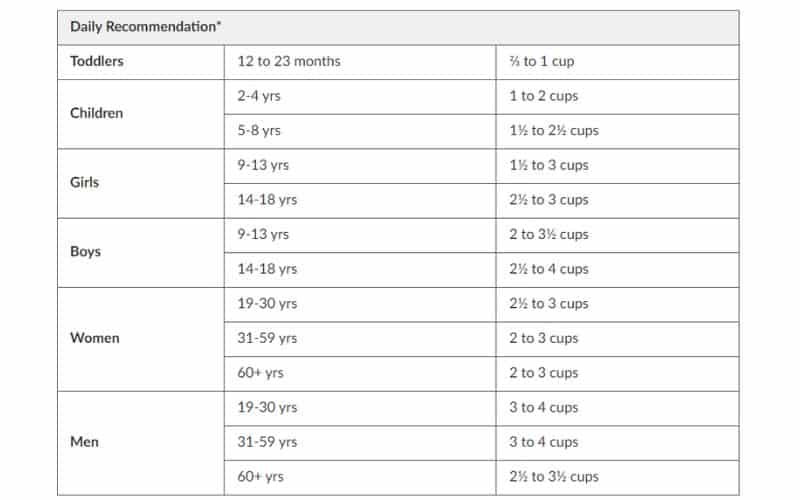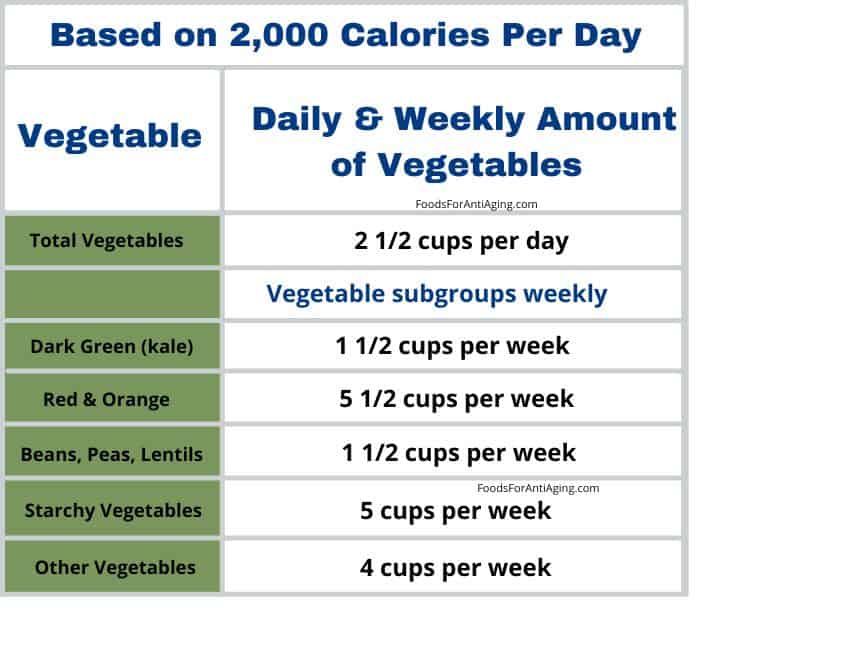This Is How Much Kale You Should Eat Per Day
During my Health Coaching Sessions clients often bring up kale. Since it’s beneficial, many people may want to eat more of it. This may lead you to wonder, how much kale should you eat per day?
The USDA recommendation for dark green vegetables, including kale, is consuming 1 1/2 cups per week based on a 2,000 calorie per day diet. This equals almost 1/4 cup of kale or dark green vegetables per day (0.21 of a cup). For raw kale, the recommendation is almost 1/2 cup per day or 0.42 of a cup.
This article will discuss in more detail about the different recommendations for vegetables per day and week. The correct amount for you may vary on several factors which are addressed in this article.
How Much Kale to Eat Per Day
The table below is the USDA recommendation for how many vegetables to eat per day and week based on a 2,000 calorie per day diet.
| Vegetable | Daily & Weekly Amount of Vegetables
Based on 2,000 calories per day |
| Total Vegetables | 2 1/2 cups per day |
| Vegetable subgroups in weekly amounts | |
| Dark Green Vegetables (kale) | 1 1/2 cups per week |
| Red and Orange Vegetables | 5 1/2 cups per week |
| Beans, Peas & Lentils | 1 1/2 cups per week |
| Starchy Vegetables | 5 cups per week |
| Other Vegetables | 4 cups per week |
The number of vegetables you need to eat per day or week depends on your age, sex, height, weight, and level of physical activity. For women health, the amount may depend on whether you are pregnant or breastfeeding.
Based on a 2,000 calorie per day diet:
- Consume 1 1/2 cup of kale or dark green vegetables per week.
- Consume 0.21 of a cup of cooked kale per day.
- Consume 0.42 of a cup of raw kale per day.
The number of cups above are for dark greens. The USDA recommends consuming different types of dark greens and not just kale.
Limiting kale intake leaves room for more of the other recommended vegetables. This would improve your nutrient intake with a wider variety of minerals, vitamins and antioxidants contained in other vegetables1.
This is exactly what I do with my daily nutrition. I often mix healthy green vegetables like kale, spinach, collards and broccoli. It takes advantage of the different nutrients offered by all. In addition, it breaks my boredom if only eating one kind of food.
Find the exact amount for you by getting your My Plan down further. For general recommendations by age, see the table below.
The following are the USDA general guidelines for how many cups of total vegetables for the day based on age2.

What counts as a cup of green vegetables?
In general, 1 cup of raw or cooked vegetables or vegetable juice, or 2 cups of raw leafy salad greens can be considered as 1 cup from the vegetable group. Therefore, 2 cups of raw kale equal one cup.
The table below lists specific amounts counting as 1 cup of vegetables towards your recommended intake.

MyPlate Plan and Diet
The number of cups may vary for you depending on your age, sex, weight, height and activity level. Find out your exact recommendation for kale and other vegetables you should consume below by clicking on the start button on the Get Your MyPlate Plan below.
After totaling calories, click on the calories for your specific plan and find the number of cups for vegetables.

Eating Side Effects
Health Complications
Eating kale is best in moderation, as too much eating per day can lead to complications like:
- Digestive issues: Eating kale can cause bloating in people who have difficulty digesting FODMAPs3 which are carbs found in some food. In addition, cruciferous vegetables can cause gastrointestinal distress if you have a C. diff infection4.
- Fatigue: The fatigue can be caused in two ways. A long-chain wax found on dark leafy greens can affect energy. In addition, it can contribute to thyroid problems and cause someone to feel tired.
- Thyroid disease: According to Oregon State University, eating extremely high intakes of cruciferous vegetables have been found to cause hypothyroidism in animals5.
These side effects of kale are rare unless you are prone to thyroid complications or eat way too much.
People on Certain Medications
In addition, people who take certain medications should maybe limit their intake:
- People who use beta-blockers
- People with kidney disease
- People who take blood thinners
Anyone taking any of the above medications should speak to their physicians about foods to avoid or limit.
Allergy
An allergy to kale may result in the following symptoms:
- Hives
- Itchy skin
- Digestive issues
- Dizziness
- Swelling of the mouth, lips and throat
If you find yourself in the small group of people with allergic reactions to cruciferous vegetables, avoid them and consult with your physician6.

Addition resources7
If you have any questions about this article don’t hesitate to comment below or email us. You can find an email on our contact page.
Read More Vegetable Related Articles
Kale vs Spinach: Which is Better? A Complete Comparison
Organic Kale vs Regular Kale: What’s the Difference?
21 Best Anti-Aging Vegetables for a Healthier You
The 6 Best Vegetables to Go With Blueberries
5 Best Alternatives for Spinach When Cooking
Should Salad be Served in a Bowl or a Plate?
What is Kale? Types, Nutrients and Benefits
- Health.gov: Dietary Guidelines For Americans 2020-2025 [↩]
- USDA MyPlate: Vegetables [↩]
- Wikipedia: FODMAP [↩]
- CDC: What is C. diff? [↩]
- Oregon State University: Cruciferous Vegetables [↩]
- Oxford Academic: Allerbase: a comprehensive allergen knowledgebase [↩]
- CDC: Only 1 in 10 Adults Get Enough Fruits or Vegetables [↩]
